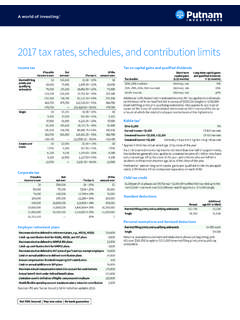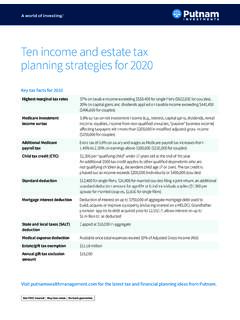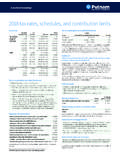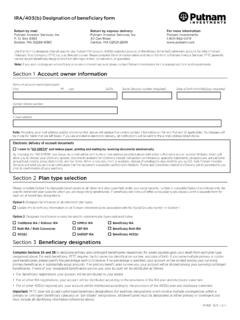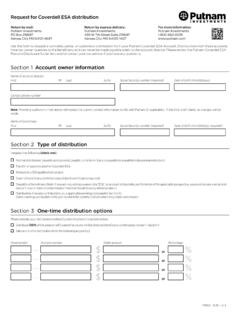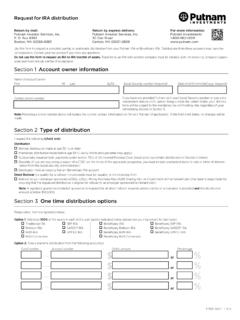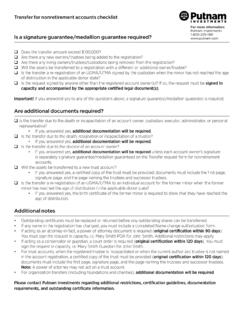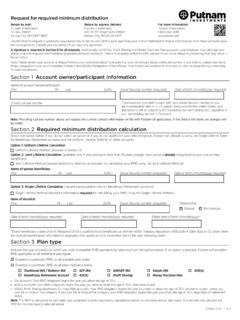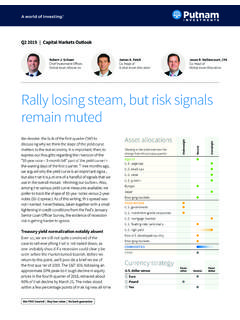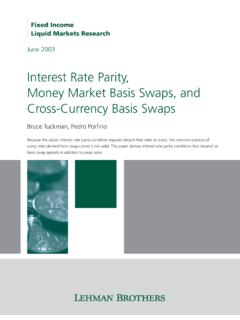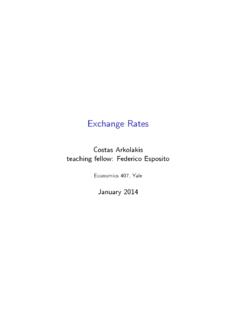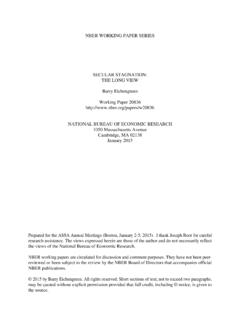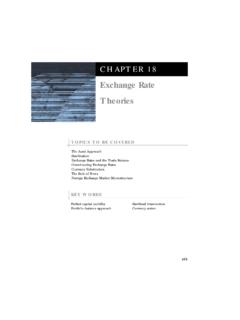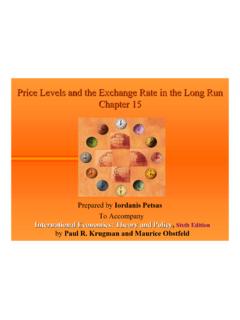Transcription of Putnam PanAgora Risk Parity Fund
1 Risk Parity diversifies across a variety of risks for different economic environmentsThe fund invests with the belief that risk diversification can generate more stable returns and greater downside protection than traditional balanced asset allocation. The portfolio is designed to participate in periods of economic growth with an allocation to equities, to preserve capital during periods of economic contraction with an allocation to fixed-income securities, and to preserve real rates of return during periods of heightened inflation with an allocation to asset-balanced portfolios have unbalanced risksA 60/40* balanced portfolio is dominated by equity risk and is designed primarily for growth environments.
2 Not for contractionary or inflationary balance40% 60%10%90%BondsContractionEquitiesGrowthE xposures to economic environmentsPutnam PanAgora Risk Parity Fund seeks to balance risksRisk Parity portfolios are diversified with additional risk contributions for different economic balance40% 40%20%40% 40%20%BondsInflation protectionEquitiesContractionInflationGr owthExposures to economic environmentsCurrent contributions to risk exposuresas of 9/30/18 CommoditiesBondsEquity40%40%20%18%33%49% Strategic targetCurrent weighting* 60% S&P 500 Index, 40% Bloomberg Barclays Global Aggregate Bond | 2018 ObjectiveThe fund seeks total return, a combination of capital appreciation and managersEdward E.
3 Qian, , CFA(industry since 1996)Bryan D. Belton, CFA(industry since 1997)Morningstar categoryTactical AllocationLipper categoryAlternative Global MacroInceptionSeptember 20, 2017 Putnam PanAgora Risk Parity Blended Benchmark35% MSCI ACWI Index50% Bloomberg Barclays Long Treasury Index15% S&P GSCI Fund symbolsClass A PPRPXC lass B PPRLXC lass C PPRNXC lass M PPRVXC lass R PPROXC lass R6 PPRWXC lass Y PPRYXD ividend frequencyAnnuallyNet assets$ ratio(Y shares)Total expense you What you pay reflectsPutnam Management sdecision to contractually limit expenses through 12/30 PanAgora Risk Parity FundPursuing total return with strategies for a range of economic environmentsBalanced for all marketsThe fund pursues total return with strategic diversification across asset classes for changing market strategy pioneerPanAgora has more than two decades of investment experience, including actively managing risk Parity strategies for institutional investors since risk managementThe fund seeks to balance risk across and within asset classes using proprietary risk-budgeting techniques.
4 Including dynamic risk in a portfolioThe fund offers diversification across asset classes and global markets for all economic conditions. Putnam Retail ManagementFS802_Y 313863 11/18 Diversification does not guarantee a profit or ensure against loss. It is possible to lose money in a diversified portfolio. For informational purposes only. Not an investment fund s benchmark is a custom blend representing 35% MSCI ACWI Index, 50% Bloomberg Barclays Long Treasury Index, and 15% S&P GSCI . Global 60/40 is composed of 60% MSCI World Index and 40% FTSE World Government Bond Bloomberg Barclays Long Treasury Index is an unmanaged index of Treasury securities with maturities of 10 years or greater.
5 The MSCI ACWI (All Country World Index) Index (ND) is a free float-adjusted market capitalization index that is designed to measure equity market performance in the global developed and emerging markets. The S&P GSCI Index is a composite index of commodity sector returns that represents a broadly diversified, unleveraged, long-only position in commodity futures. The MSCI World Index (ND) is an unmanaged index of equity securities from developed countries. The FTSE World Government Bond Index is an unmanaged index generally considered to be representative of the world bond market. Index returns do not reflect any fees, expenses, or sales charges.
6 You cannot invest directly in an these risks before investing: There can be no assurance that a risk Parity approach will achieve any particular level of return or will, in fact, reduce volatility or potential loss. The fund s allocation of assets may hurt performance, and efforts to diversify risk through the use of leverage may be unsuccessful. Quantitative models or data may be incorrect or incomplete, and reliance on those models or data may not produce the desired results. Asset prices may fall or fail to rise over time for several reasons, including general financial market conditions, changing market perceptions (including, in the case of bonds, perceptions about the risk of default and expectations about monetary policy or interest rates), changes in government intervention in the financial markets, and factors related to a specific issuer, industry or commodity.
7 These and other factors may also lead to increased volatility and reduced liquidity in the fund s portfolio holdings. Investments in small and/or midsize companies increase the risk of greater price fluctuations. Bond investments in which the fund invests (or has exposure to) are subject to interest-rate risk and credit risk. Interest-rate risk is generally greater for longer-term bonds, and credit risk is generally greater for below-investment-grade bonds. The value of inflation-protected securities generally declines during periods of rising real interest rates, and, when real interest rates rise faster than nominal interest rates, inflation-indexed bonds to which the fund is exposed may experience greater losses than other fixed income securities with similar durations.
8 Exposure to the commodities markets may subject the fund to greater volatility than investments in traditional securities. risks associated with derivatives (including short derivatives) include losses caused by unexpected market movements (which are potentially unlimited), imperfect correlation between the price of the derivative and the price of the underlying asset, increased investment exposure (which may be considered leverage), the potential inability to terminate or sell derivatives positions, the potential need to sell securities at disadvantageous times to meet margin or segregation requirements, the potential inability to recover margin or other amounts deposited from a counterparty, and the potential failure of the other party to the instrument to meet its obligations.
9 Leveraging can result in volatility in the fund s performance and losses in excess of the amounts invested. International investing involves certain risks , such as currency fluctuations, economic instability, and political developments. The fund invests in (or provides exposure to) fewer issuers or makes large investments in (or provides large amounts of exposure to) a small number of issuers, and involves more risk than a fund that invests more broadly. By investing in open-end or closed-end investment companies and ETFs, the fund is indirectly exposed to the risks associated with direct ownership of the securities held by those investment companies or ETFs.
10 By investing in a subsidiary, the fund is indirectly exposed to the risks associated with the subsidiary s investments. You can lose money by investing in the should carefully consider the investment objectives, risks , charges, and expenses of a fund before investing. For a prospectus, or a summary prospectus if available, containing this and other information for any Putnam fund or product, call your financial representative or call Putnam at 1-800-225-1581. Please read the prospectus carefully before Investments | 100 Federal Street | Boston, MA 02110 | total return performance Inception 9/20/17 Class Y sharesPutnam PanAgora Risk Parity Blended Benchmark*Global 60/40* of performance may be lower or higher than the quoted past performance, which cannot guarantee future results.
